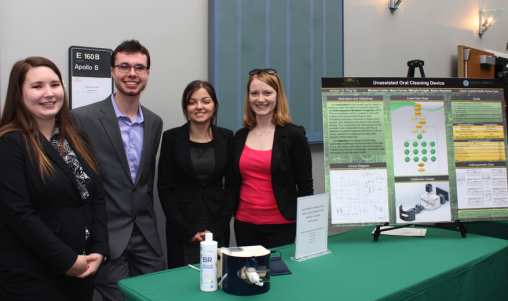
From left: Biomedical engineering students Mikayla Padgitt, Michael Collier, Skylar Rountree and Mary Farrow won the College of Engineering and Computer Science Senior Design Showcase for their automatic toothbrush.
For most people, brushing their teeth may seem like a fairly mundane task. For those with mobility issues, however, brushing their teeth may be exceedingly difficult or even impossible.
Biomedical engineering majors Michael Collier, Mary Farrow, Mikayla Padgitt and Skylar Rountree aimed to fix that with their engineering capstone project.
The students’ project, an “Unassisted Oral Cleaning Device,” is an automatic toothbrush that is connected to two motors. One rotates the toothbrush to the left and right, while the other turns the toothbrush 90 degrees to clean the sides and front of the user’s teeth. The user can activate the device by leaning forward to put their mouth around the toothbrush. The user’s shadow activates a light sensor that triggers the brushing process to begin.
Ping He, professor of biomedical engineering, advised the students with the project, which took place over two courses during the fall and spring semesters.
The idea came from Padgitt’s mother’s best friend, who is a caregiver for a child with Arthrogryposis Multiplex Congenita, a disorder that immobilizes joints. Eventually, the students hope to give the completed device to the child.
Farrow said the team split the work across two semesters. The students spent the fall semester brainstorming, as well as figuring out the coding and necessary circuitry. They worked on building the device during the spring semester.
The team planned to have plenty of extra time, but 3D printing the casing for the motors and circuitry posed a problem. One of the companies they considered using wanted to charge them $2,500 to print. With a budget of $700, that was out of the question.
Because of the delay in the printing process, the students received their printed casing less than a week before the preliminary judging. The night before their project was due, the team pulled an all-nighter.
“Our chemistry is what brought us this far, 100 percent,” Rountree said.
Collier agreed. “We never started fighting in the first place, so when push really got to shove, instead of going from a little bit of fighting to attacking each other, we went from no fighting to frayed nerves,” he said.
After the preliminary judging of the project, the team qualified for the Senior Design Showcase — a gathering of best projects from the preliminary round — organized by the College of Engineering and Computer Science. Eight entries were in the showcase.
Padgitt said she felt like her team won because their project combined 3D printing, circuitry, coding and mechanics.
“From the way I’ve always seen it, we’re the hybrid engineer,” Collier said. “We can do some of everything and this project was very much that. We did pretty much everything that you do in engineering. Coming out of the project, I can say ‘yeah, I’m an engineer.’”

 Wright State business professor, alumnus honored by regional technology organizations
Wright State business professor, alumnus honored by regional technology organizations  Wright State University Foundation awards 11 Students First Fund projects
Wright State University Foundation awards 11 Students First Fund projects  Gov. DeWine reappoints Board Treasurer Beth Ferris and names student Ella Vaught to Wright State Board of Trustees
Gov. DeWine reappoints Board Treasurer Beth Ferris and names student Ella Vaught to Wright State Board of Trustees  Joe Gruenberg’s 40-Year support for Wright State celebrated with Honorary Alumnus Award
Joe Gruenberg’s 40-Year support for Wright State celebrated with Honorary Alumnus Award  Wright State’s elementary education program earns A+ rating for math teacher training
Wright State’s elementary education program earns A+ rating for math teacher training 